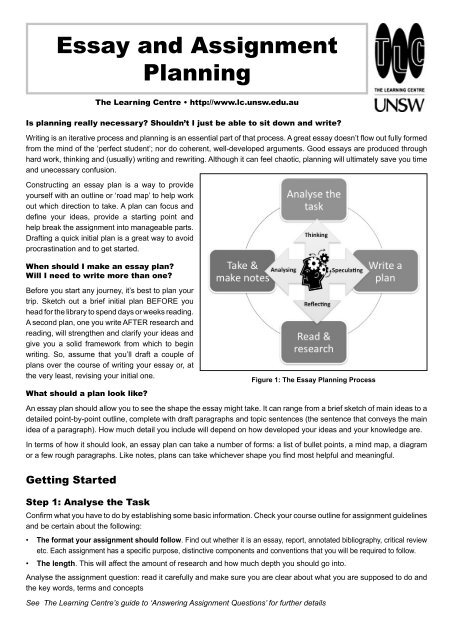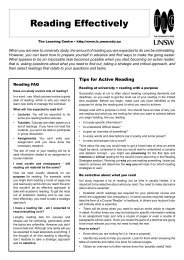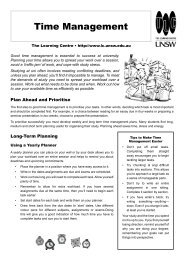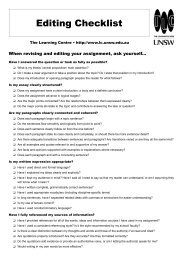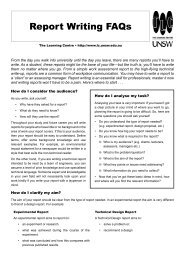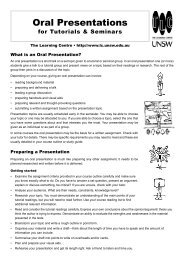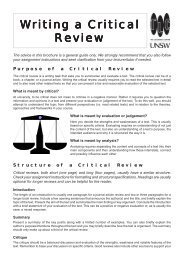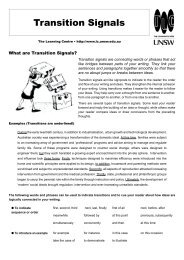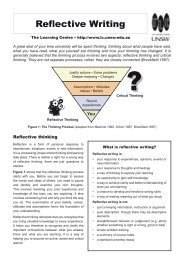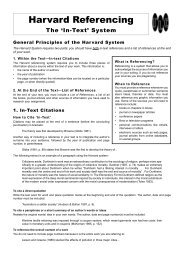Essay and Assignment Planning - The Learning Centre - University ...
Essay and Assignment Planning - The Learning Centre - University ...
Essay and Assignment Planning - The Learning Centre - University ...
You also want an ePaper? Increase the reach of your titles
YUMPU automatically turns print PDFs into web optimized ePapers that Google loves.
<strong>Essay</strong> <strong>and</strong> <strong>Assignment</strong><br />
<strong>Planning</strong><br />
<strong>The</strong> <strong>Learning</strong> <strong>Centre</strong> • http://www.lc.unsw.edu.au<br />
Is planning really necessary? Shouldn’t I just be able to sit down <strong>and</strong> write?<br />
Writing is an iterative process <strong>and</strong> planning is an essential part of that process. A great essay doesn’t flow out fully formed<br />
from the mind of the ‘perfect student’; nor do coherent, well-developed arguments. Good essays are produced through<br />
hard work, thinking <strong>and</strong> (usually) writing <strong>and</strong> rewriting. Although it can feel chaotic, planning will ultimately save you time<br />
<strong>and</strong> unecessary confusion.<br />
Constructing an essay plan is a way to provide<br />
yourself with an outline or ‘road map’ to help work<br />
out which direction to take. A plan can focus <strong>and</strong><br />
define your ideas, provide a starting point <strong>and</strong><br />
help break the assignment into manageable parts.<br />
Drafting a quick initial plan is a great way to avoid<br />
procrastination <strong>and</strong> to get started.<br />
When should I make an essay plan?<br />
Will I need to write more than one?<br />
Before you start any journey, it’s best to plan your<br />
trip. Sketch out a brief initial plan BEFORE you<br />
head for the library to spend days or weeks reading.<br />
A second plan, one you write AFTER research <strong>and</strong><br />
reading, will strengthen <strong>and</strong> clarify your ideas <strong>and</strong><br />
give you a solid framework from which to begin<br />
writing. So, assume that you’ll draft a couple of<br />
plans over the course of writing your essay or, at<br />
the very least, revising your initial one.<br />
What should a plan look like?<br />
Figure 1: <strong>The</strong> <strong>Essay</strong> <strong>Planning</strong> Process<br />
An essay plan should allow you to see the shape the essay might take. It can range from a brief sketch of main ideas to a<br />
detailed point-by-point outline, complete with draft paragraphs <strong>and</strong> topic sentences (the sentence that conveys the main<br />
idea of a paragraph). How much detail you include will depend on how developed your ideas <strong>and</strong> your knowledge are.<br />
In terms of how it should look, an essay plan can take a number of forms: a list of bullet points, a mind map, a diagram<br />
or a few rough paragraphs. Like notes, plans can take whichever shape you find most helpful <strong>and</strong> meaningful.<br />
Getting Started<br />
Step 1: Analyse the Task<br />
Confirm what you have to do by establishing some basic information. Check your course outline for assignment guidelines<br />
<strong>and</strong> be certain about the following:<br />
• <strong>The</strong> format your assignment should follow. Find out whether it is an essay, report, annotated bibliography, critical review<br />
etc. Each assignment has a specific purpose, distinctive components <strong>and</strong> conventions that you will be required to follow.<br />
• <strong>The</strong> length. This will affect the amount of research <strong>and</strong> how much depth you should go into.<br />
Analyse the assignment question: read it carefully <strong>and</strong> make sure you are clear about what you are supposed to do <strong>and</strong><br />
the key words, terms <strong>and</strong> concepts<br />
See <strong>The</strong> <strong>Learning</strong> <strong>Centre</strong>’s guide to ‘Answering <strong>Assignment</strong> Questions’ for further details
Step 2: Work out your initial thoughts<br />
<strong>and</strong> ideas about the topic(s)<br />
• Do you have any initial responses to the question? What could<br />
a possible answer (or answers) be?<br />
• Do you have any opinions at all about the topic(s)? Write<br />
them down, no matter how ‘creative’ or non-academic they<br />
may be.<br />
• What do you already know about the topic(s)? Do you have<br />
knowledge than can be built on, such as familiarity with<br />
related areas, sources or frameworks for thinking about<br />
similar topics? Write everything down—you may know more<br />
than you think.<br />
Further your thinking by ‘questioning the question’. This helps<br />
you focus by drawing out sub-questions about the question <strong>and</strong><br />
topic.<br />
• Question the terms – Is there a generally agreed-upon response<br />
to the question or approach to take?<br />
• If not, how do different approaches/ theories/ arguments differ?<br />
Which ones could/ should you use?<br />
• What are the key concepts? How do they relate to each other?<br />
Generate ideas through brainstorming. Come up with as<br />
many ideas as you can as quickly as you can. Don’t evaluate<br />
or discard anything – you can do that later – just jot them down.<br />
Use mindmaps, drawings <strong>and</strong> lists; whatever comes to mind <strong>and</strong><br />
stimulates your thinking. Look at what you’ve noted down. Pull out<br />
the points that are relevant to the question <strong>and</strong> discard the rest.<br />
I’m supposed to write an<br />
essay plan for my course—<br />
what should it consist of?<br />
Students are sometimes asked to submit a<br />
preliminary essay plan or outline as part of<br />
their course. This might be done as a prelude<br />
to completing a major essay, or it might be<br />
an individual form of assessment.<br />
<strong>The</strong> purpose of setting this kind of assignment<br />
is to encourage students to start enaging with<br />
the essay topic early in the semester <strong>and</strong> to<br />
provide feedback to help them proceed.<br />
If you have been asked to submit an essay<br />
plan or outline as a course assignment,<br />
there will usually be guidelines to follow. A<br />
plan usually requires a thesis statement <strong>and</strong><br />
an indication of main points. Other than that,<br />
clarify what your tutor/ lecturer has in mind.<br />
You need to know:<br />
• What form the plan should take. Should<br />
it be a list of points, a diagram etc?<br />
• <strong>The</strong> amount of detail required. Should<br />
you indicate sources for research,<br />
should you provide references, etc?<br />
Step 3: Construct an initial essay plan<br />
After you have generated some ideas, it’s important to write an initial plan before you head for the library. This can feel<br />
strange—after all, how can you answer a question when you haven’t done any research?—but starting with an initial plan<br />
helps you order your ideas <strong>and</strong> focus your reading. Without a sense of which direction to head in, it’s easy to get lost in<br />
the research process. This initial plan will be provisional <strong>and</strong> might consist of:<br />
• a provisional answer to the question (or thesis statement)<br />
• a brief outline of possible main points.<br />
As you research <strong>and</strong> develop your underst<strong>and</strong>ing of the topic, your ideas will likely change, <strong>and</strong> your answers may<br />
change with them. Try to see your essay plan as something that evolves as you engage further with your topic.<br />
While it’s a good idea to write an initial plan before you start researching, if you really know nothing at all about the topic,<br />
some initial skimming <strong>and</strong> browsing through recommended or assigned readings can provide a few ideas. However, the<br />
initial planning stage is not the time for a lot of intensive or detailed reading.<br />
Step 4: Research <strong>and</strong> gather information<br />
Your initial plan should raise a series of questions <strong>and</strong> identify key words <strong>and</strong> topic areas which you can use to orientate your<br />
research for the essay. While reading informs your thinking, knowing what you need to find out will give your reading a purpose.<br />
See ‘Starting your research’ from ELISE (UNSW Library): http://elise.library.unsw.edu.au/mod3/study2.html<br />
• Be sure to examine any assigned course readings that are relevant to your essay topic.<br />
• If there was a lecture on the essay topic, did the lecturer recommend or refer to any particular author?<br />
• Is there a list of recommended readings for the course? Refer to it for sources of information. Who has written what<br />
on the topic(s)? What is essential to read?<br />
• Use the key words <strong>and</strong> topics gleaned from your initial plan for library keyword searches.<br />
• Notemaking as you read helps you record how you know something <strong>and</strong> helps you avoid plagiarism.
What elements should an essay plan consist of?<br />
A thesis statement<br />
A plan should indicate the answer to the question: write a<br />
1-2 sentence thesis statement.<br />
A thesis statement is a sentence (or two) that answers the essay<br />
question. A clear <strong>and</strong> well-written thesis statement will help you<br />
to determine the direction <strong>and</strong> structure of your argument.<br />
In the initial plan, the thesis statement is usually provisional.<br />
However, after you’ve done some research, you will need to work<br />
on your thesis statement until it is clear, concise <strong>and</strong> effective.<br />
What is a thesis statement?<br />
A thesis statement is:<br />
• a clear <strong>and</strong> direct answer to the essay<br />
question<br />
• a claim that can be discussed <strong>and</strong><br />
exp<strong>and</strong>ed further in the body of the essay<br />
• one or two complete sentences<br />
• part of the introduction<br />
Tips: Try introducing your thesis statement with<br />
the phrase ‘this essay will argue’ or ‘this essay<br />
argues’. Paraphrasing the assignment question<br />
can help ensure that you are answering it.<br />
Main Points<br />
A plan should indicate possible main points.<br />
Once you have a thesis statement, follow it with a paragraph or a<br />
set of points that indicate the ‘reasons why’ for your answer. <strong>The</strong><br />
‘reasons why’ can be developed into the main points of your essay.<br />
In the initial plan, try to express the main Idea of each point in a<br />
single, clear sentence. <strong>The</strong>se can become topic sentences (the<br />
first sentence of each paragraph) when, in your second plan, you<br />
develop these points further.<br />
Arrange your main points in a logical order <strong>and</strong> number them<br />
(is there one that would seem to go first or one that would seem<br />
to go last? Are there any two that are closely linked? How are<br />
the ideas connected to each other? Do the main points, when<br />
considered as a whole, present a unified discussion?).<br />
Structure<br />
What are main points?<br />
• Main points make up the body of an essay.<br />
• Each point should be developed in a<br />
paragraph. <strong>The</strong>se paragraphs are the<br />
building blocks used to construct the<br />
argument.<br />
• In a 1000-1500 word essay, aim for three<br />
to four main points.<br />
What is a topic sentence?<br />
<strong>The</strong> topic sentence is the main sentence of a<br />
paragraph, which establishes its central idea<br />
<strong>and</strong> indicates the direction the supporting<br />
sentences will take. <strong>The</strong> topic sentence is<br />
usually the first sentence in a paragraph.<br />
A plan should follow the structure of an essay (eg.<br />
Introduction, body <strong>and</strong> conclusion).<br />
While you may not be ready to construct an introduction or<br />
conclusion, this three-part structure should be at least suggested<br />
in your plan.<br />
<strong>The</strong> introduction is where you answer<br />
the question <strong>and</strong> provide an outline of<br />
the essay’s main ideas.<br />
Research<br />
A plan should include some indication of the evidence you<br />
might use.<br />
Make a few notes about how each main point might be developed.<br />
Consider <strong>and</strong> if possible, specify the evidence you might draw on<br />
<strong>and</strong> which texts you might refer to. Jot down titles, authors, page<br />
numbers etc.<br />
<strong>The</strong> body is where you answer the question<br />
by developing a discussion through offering<br />
explanation <strong>and</strong> evidence.<br />
<strong>The</strong> conclusion is where you restate<br />
the thesis <strong>and</strong> re-summarise the main<br />
points.
Step 5: Write a second essay plan<br />
After you’ve researched <strong>and</strong> your ideas are more developed,<br />
it’s time to write a second plan. This one might be a detailed<br />
point-by-point outline complete with paragraphs <strong>and</strong> topic<br />
sentences. How much detail you can include will depend<br />
on how developed your knowledge <strong>and</strong> ideas are. You can<br />
also return to your initial plan <strong>and</strong> revise it.<br />
Questions to ask yourself:<br />
• In light of your research, has your answer changed?<br />
If yes, write a new thesis statement. Now is the time to<br />
ensure it is clear, concise <strong>and</strong> fully answers the essay<br />
question.<br />
• Are the main points still relevant?<br />
Are they still in line with your thesis statement? What<br />
should you add or change?<br />
• Is each main point expressed as a topic sentence?<br />
Specify each point the essay will make by writing the<br />
main idea in a single sentence.<br />
• How does each point relate to the question?<br />
Include a brief sentence explaining how each point<br />
relates to the question – doing this can make sure<br />
your discussion stays on course. If you can’t see how<br />
a particular point relates to the question, delete it.<br />
• How will you develop each main point?<br />
How will you explain <strong>and</strong> illustrate each one? What<br />
evidence or examples might you use?<br />
• Do you have specific evidence to draw on?<br />
Specify the texts you will refer to. Jot down titles,<br />
authors, page numbers.<br />
• How does each main point link together?<br />
How is each one connected? Are they in logical order?<br />
When you have an outline, make a few rough notes to get the<br />
introduction <strong>and</strong> conclusion started. Start thinking about:<br />
• how you will introduce <strong>and</strong> ‘lead the reader in’ to the topic<br />
• how to conclude <strong>and</strong> ‘close the door’ on the topic<br />
Do this last, as you can’t know how you’re going to<br />
introduce or conclude something until you’re clear about<br />
what you’re going to say.<br />
Should I write while I’m researching?<br />
YES. Writing is a means of thinking <strong>and</strong> working out<br />
ideas. A ‘writing-as-you-go’ approach helps you to<br />
avoid a ‘split’ process, where you do lots of reading,<br />
defer writing until the last minute, <strong>and</strong> so experience<br />
a lot of confusion.<br />
Try the following strategies:<br />
• During each study session, set yourself a goal<br />
<strong>and</strong> spend 5-10 minutes writing. As you think<br />
through ideas, try expressing them in short<br />
paragraphs. You might produce some that are<br />
well-developed <strong>and</strong> require little revision. Other<br />
fragments might require a lot of rewriting. That’s<br />
fine—the point is, you’re not starting with a<br />
blank page.<br />
• Use the split-page notemaking method to make<br />
notes <strong>and</strong> write as you read. In addition to noting<br />
specific information, write your comments <strong>and</strong><br />
ideas. You don’t have to write perfect sentences,<br />
but writing-as-you-go can mean that by the time<br />
you’re ready to write a first draft, you’ll already have<br />
a framework of notes <strong>and</strong> comments to build on.<br />
• As you read, write in response to these<br />
questions:<br />
◊ in what ways is what I’ve been reading<br />
relevant to my essay?<br />
◊ What more do I need to find out <strong>and</strong> why?<br />
◊ How does what I’m reading link in to what I<br />
already know?<br />
• Try freewriting (or ‘stream-of-consciousness’<br />
writing) – a technique in which you write<br />
continuously for a set period of time. Write in<br />
full sentences <strong>and</strong> don’t worry about spelling<br />
or grammar. If you can’t think of what to write,<br />
don’t slow down, just repeat the last phrase<br />
you wrote. Freewriting is often used to collect<br />
initial thoughts <strong>and</strong> ideas on a topic, often as a<br />
preliminary to formal writing. It is also a great<br />
way to overcome writer’s block.<br />
References<br />
Emerson, L (ed) 2005, Writing Guidelines for Social Science Students, Dunmore Press, Victoria.<br />
Fletcher, C 1995, <strong>Essay</strong> clinic: a structural guide to essay writing, Macmillan, Melbourne.<br />
Monash <strong>University</strong> <strong>Learning</strong> Support 2009, Thinking strategies: <strong>Learning</strong> Support for Higher Degree Research Students,<br />
Monash <strong>University</strong> accessed 17 August 2010 <br />
Roehampton <strong>University</strong> 2010, <strong>Essay</strong> planning: <strong>Essay</strong>ing academic writing, Roehampton <strong>University</strong>, accessed 28 July 2010<br />
<br />
Taylor, G 2009, A student’s writing guide: how to plan <strong>and</strong> write successful essays, Cambridge <strong>University</strong> Press, New York.<br />
Prepared by Tracey-Lee Downey for <strong>The</strong> <strong>Learning</strong> <strong>Centre</strong>, <strong>The</strong> <strong>University</strong> of New South Wales © 2010. This guide may be<br />
distributed for educational purposes, <strong>and</strong> the content may be adapted with proper acknowledgement. <strong>The</strong> document itself<br />
must not be digitally altered or rebr<strong>and</strong>ed. Email: learningcentre@unsw.edu.au


